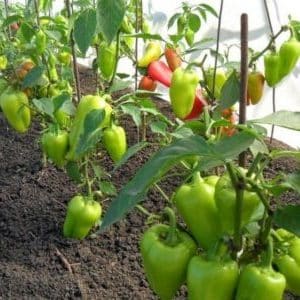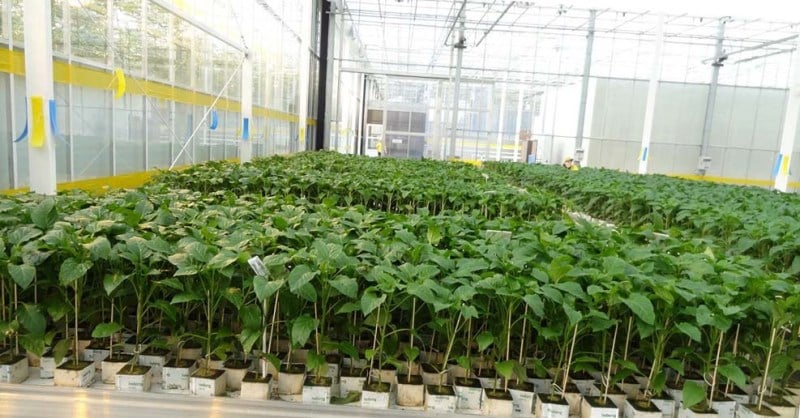When and how to plant peppers in a greenhouse correctly: step-by-step instructions for beginning gardeners
Novice gardeners grow bell pepper seedlings on window sills and balconies and are looking for advice on when and how to plant peppers in a greenhouse. And if in the southern regions seedlings can easily grow simply in the ground, then in the middle zone and northern regions you have to try to ensure that the vegetable bears fruit.
Read our article about how to properly cultivate bell peppers in protected soil.
Timing for planting seedlings in a greenhouse
There is no specific date for planting seedlings. Experienced gardeners carefully monitor the weather, temperature, and sun to decide on planting time. Most often this happens in mid-May.
However, there are universal requirements for planting seedlings in a greenhouse:
- The seedlings were planted about two months ago (60-70 days).
- The stems have at least 10 leaves and reach a height of 25-30 cm.
- The temperature in the greenhouse does not drop below 10°C, especially at night.
- The soil in the greenhouse warmed up to 15-18°C.
- If the bed is in the shade, then it is planted later than the climate norm.
- Seedlings are planted in the ground in cloudy weather. If this is not possible, then in the morning or evening
If you pay attention to folk signs, then the plants are planted in the greenhouse when the coltsfoot begins to fade and the rowan begins to bloom. But you can plant peppers in open ground when the rose hips begin to bloom: people have always believed that this means the end of morning frosts.
It wouldn’t hurt to look at the lunar calendar and decide on approximate dates. Planting is prohibited on days when there is a new moon and a full moon.
Important! Frosts often occur in late May - early June, so be sure to provide additional heating for the greenhouse and the seedlings themselves.
Greenhouse and soil preparation
There are two ways to prepare the soil for peppers. Manipulations begin in the fall.
1 way:
- Remove the soil in the greenhouse by 30 cm.
- Place small leaves, humus, straw on the bottom and fill the bed with soil and water.
- Scatter the fallen snow over the surface of the ground in the greenhouse.
This is the so-called “warm” bed.
Method 2:
- Dig up the soil, clear it of weeds and unnecessary vegetation and stones.
- Apply organic fertilizers in the form of compost or rotted manure at the rate of 1-2 buckets per 1 square meter. m.
- A week before planting seedlings, water the soil with a solution of complex mineral fertilizers.
- Before starting work, water the beds with water previously melted from the last spring snow.
In the last days of March, the soil and the structure itself are disinfected from pests and pathogenic microbes. To do this, the insides of the greenhouse are treated with a solution of laundry soap and a smoke bomb is used to disinfect the soil.
Bulgarian vegetables require fertile soil for a good harvest, so you should first apply nitrogen-phosphorus fertilizers at the rate of 40 g per 1 sq. m. m.
If the soil is acidic in the greenhouse, the beds are sprinkled with wood ash or dolomite flour. If the soil is heavy (loam, clay), sawdust, peat, rotted manure or sand are added to lighten it.
For lovers of magic and conspiracies! When planting peppers, a conspiracy is pronounced:
“Be born, peppers, large and great, for old and small, baptized for the whole world”
Planting process

Two weeks before planting peppers, gardeners advise starting to harden off seedlings. To do this, take the seedlings outside first only on a sunny warm day, and in the last couple of days they leave them overnight.
Two days before planting, the plants are watered with a solution of potassium fertilizers and sprayed with Bordeaux mixture (a mixture of slaked lime and copper sulfate), which helps protect the seedlings from fungal and bacterial diseases. The mixture is prepared at the rate of 50 g per 10 liters of water.
It is better to plant seedlings in individual peat cups - there will be no problems when planting in a greenhouse - the roots are not injured during transplantation.
In cases where peppers grow in a common container, holes are prepared in the garden bed for each bush to the same depth as in pots. Water the seedlings before transplanting, allowing time to soak in. They are taken out with a spoon, without pulling by the stem, but by prying from below, in order to injure the roots and stem as little as possible.
When many extra branches form on the stems below, they are carefully cut off or torn off so that they do not take nutrients for themselves.
Important! When planting seedlings in the ground, you should not bury the root collar of the plant.
Planting scheme
The harvest largely depends not only on the time of planting, but also on the correct formation of the ridge.
Distance when planting seedlings
Still at the stage selection of pepper varieties it is worth considering the area and height of the greenhouse, the method growing. It is worth growing low-growing varieties in a low greenhouse, and frost-resistant varieties in open ground.

Rules for forming a ridge:
- tall varieties are placed at a distance of 30-40 cm from each other;
- low-growing varieties - 25-30 cm;
- the distance between the rows is 70-80 cm so that there is room for crown formation.
Bush formation
It is worth forming a bush in tall varieties. In short-growing plants, excess, rotting or diseased shoots are simply removed.
Follow these guidelines:
- They begin to form a bush from a height of 25-30 cm, a lower plant may die or stop developing;
- the very first bud is removed, then the plant will begin to actively grow new shoots;
- the stem is formed into several shoots, choosing strong and disease-free shoots, the rest are pinched or the tops are cut off;
- if the remaining shoots again form forks, then the same actions are repeated: stronger shoots are selected, the tops of the rest are pinched, the first buds are removed;
- everything that grows inside the bush is pruned, because they thicken the bush, not allowing it to bear fruit well;
- no more than 20 fruits are left on the bush;
- carefully monitor the appearance of rotten, light shoots, which are immediately removed so that diseases do not arise;
- when the peppers are fully grown, the buds are blooming, the fruits are forming, it is recommended to remove the main top, then the fruits will be larger and richer in taste;
- when the stem reaches a height of half a meter, the plant is tied to wooden mini-trellises;
- if the plant is tall and the height of the greenhouse allows, the stem is tied with a rope to the ceiling of the greenhouse.
Important! At the beginning of planting, the plant will wither, drop branches and leaves, but with proper care, after a couple of days it will perk up, raise its leaves to the sun and begin to turn green with a vengeance.

Pepper care
Caring for peppers doesn’t end there. Even timely planted seedlings and properly formed bushes require close attention.
Watering
It is important to water the peppers correctly:
- watering should be done in the morning;
- consumption: a bucket of water per 1 sq. m;
- once a week until buds form;
- twice a week during flowering and fruiting;
- direct the stream of water under the root without touching the leaves;
- use only warm and clean water to prevent plants from overcooling.
Important! Plants are watered often and little by little, because with a lack or excess of moisture the ovaries may fall off.
Top dressing
An important stage in crop formation is fertilizing:
- once every two weeks with nitrogen-containing fertilizer (urea) during the growing season;
- once every 14 days with phosphorus fertilizers during the period of fruit formation;
- It is allowed to feed with mullein a couple of times a season.
Important! If the plant drops its ovaries, it means it does not have enough sunlight. In such situations, it is worth removing all the leaves, leaving only the flowers and fruits.
Additional care
- regular weeding to remove weeds;
- loosening the soil to saturate it with oxygen;
- garter of stems;
- do not leave unattended and observe the appearance;
- leaves curled at the edges indicate a lack of potassium;
- if the underside of the leaf turns purple, it means the pepper lacks phosphorus;
- grayish leaves indicate nitrogen deficiency;
- the absence of ovaries and rapid growth of greenery indicate an excess of nitrogen, in which case watering is carried out with an infusion of ash.
Important! Too deep loosening can lead to damage to the root system, which in turn leads to the death of flowers and the death of the plant.
Conclusion
In a greenhouse, a vegetable is protected from natural disasters, but this does not automatically guarantee a high yield. The quantity and quality of fruits also depends on the efforts, competent approach and skills of the farmer.It is necessary to replant, fertilize and water the crop on time. And then the pepper will delight you with sweet, juicy fruits until late autumn.